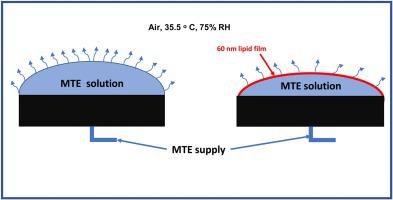Colloids and Surfaces B: Biointerfaces ( IF 5.8 ) Pub Date : 2020-10-09 , DOI: 10.1016/j.colsurfb.2020.111392 Tatyana F Svitova 1 , Meng C Lin 2

|
A novel methodology for assessing evaporation (up to 48 h) through lipid-nanofilms in vitro was developed. The influence of lipid-mixture compositions on evaporation rates was studied. The evaporative fluxes and rheology of lipid-nanofilms were compared with those of human tear-lipid nanofilms in vitro.A sessile-drop technique with precise drop-volume control was adapted to measure evaporation rates at constant temperature of 36 °C and humidity of 75 %. Model lipid solutions were deposited on the surface of aqueous drops to create nanofilms of 10–100 nm. The measurements of dynamic surface pressure vs. nanofilm-thickness were performed under the same conditions. The lipid-mixtures compositions were chosen to mimic that of human tear lipids. Evaporation through lipid nanofilms decreased with film thickness and aging. Evaporation through 70-nm films was 2.5–3 time slower than through 10-nm-thick films. Nonpolar-lipid mixtures reduced evaporation by approximately 35 %. The optimized model-lipid mixtures containing polar phospholipids reduced evaporation by 70–75 %, matching the evaporation-reduction by human-lipid nanofilms in vitro. These model mixtures exhibited interfacial rheology similar to human tear lipids in vitro.This methodology substantiated that aged lipid-nanofilms significantly reduced evaporation in vitro. These findings contradict to the previous reports suggesting that model lipid and meibum films do not retard evaporation in vitro. Polar phospholipids enhance evaporative resistance close to the level observed for human tear-lipid films in vivo. We hypothesize that unique rheological properties of tear-lipid nanofilms are germane to the specific mono- and bi-layered structures formed by phospholipids at the lipid-air and lipid-aqueous interfaces.
中文翻译:

模型泪脂膜的蒸发延迟:膜老化,成分和界面流变性质的作用
开发了评估脂质纳米膜体外蒸发(长达48小时)的新方法。研究了脂质混合物组成对蒸发速率的影响。将脂质纳米膜的蒸发通量和流变学与人泪脂质纳米膜的体外流变学进行了比较。采用精确滴量控制的无滴技术,在36°C的恒温和75°C的湿度下测量蒸发速率%。模型脂质溶液沉积在水滴表面上,形成10-100 nm的纳米膜。动态表面压力与。纳米膜厚度在相同条件下进行。选择脂质混合物组合物以模拟人眼泪脂质。通过脂质纳米膜的蒸发随膜厚度和老化而降低。通过70纳米薄膜的蒸发比通过10纳米厚薄膜的蒸发慢2.5–3倍。非极性脂质混合物将蒸发减少了大约35%。含有极性磷脂的优化模型脂质混合物可将蒸发减少70-75%,与体外人脂质纳米膜的蒸发减少相匹配。这些模型混合物在体外表现出与人泪脂质相似的界面流变学。该方法证实了老化的脂质纳米膜在体外显着减少了蒸发。这些发现与先前的报告矛盾,认为模型脂质和睑板膜不会延迟体外蒸发。极性磷脂可增强抗蒸发性,接近体内人类泪脂膜所观察到的水平。我们假设,泪脂纳米膜的独特流变特性与磷脂在脂质-空气和脂质-水界面处形成的特定单层和双层结构密切相关。



























 京公网安备 11010802027423号
京公网安备 11010802027423号